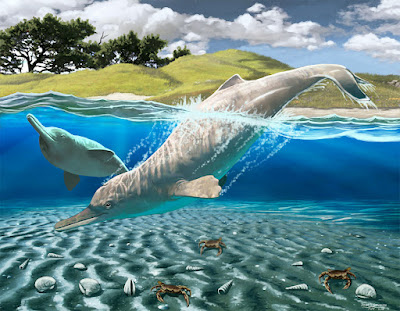 |
| Notocetus vanbenedeni Moreno, 1892 in Viglino, Buono, ... et Fordyce, 2022. |
Abstract
Platanistoidea remains one of the most evolutionarily intriguing lineages of toothed whales (Odontoceti). The clade comprises mostly extinct species from the late Oligocene–early Miocene onward and a single extant riverine genus (Platanista). There is an ongoing debate as to the membership of Platanistoidea and the causes of their near extinction. In Patagonia (Argentina), the most abundant platanistoid recorded in the lower Miocene Gaiman Formation is Notocetus vanbenedeni, first described by Moreno in 1892 based on two individuals. The goal of the present contribution is to conduct an updated anatomical, palaeobiological and phylogenetic analyses of Notocetus vanbenedeni and hence contribute to an understanding of the evolutionary history of the Platanistoidea. Our analyses, including at least 26 individuals (12 undescribed), show that Notocetus vanbenedeni is a valid platanistoid taxon, recovered as part of a new clade. Among its most outstanding features, this taxon has an elevated dorsal tubercular supraorbital crest formed mainly by the frontal, the precursor of the pneumatized crest of the extant Platanista. Notocetus vanbenedeni also shows initial stages of the plesiomorphic bony connection between the earbones and skull as in Platanista, although the functional implications for hearing remain elusive. The nasal sac system, pterygoid sinus system and morphology of the earbones suggest that this species was able to hear high-frequency sounds and echolocate underwater, similar to extant odontocetes. Thus, Notocetus vanbenedeni presents a mosaic of features that suggest an intermediate platanistoid morphotype. Anatomical differences and phylogenetic analyses suggest that Peruvian specimens could not be referred to this species. The feeding apparatus of Notocetus vanbenedeni makes it the only combination suction-feeder recorded in the early Miocene of Patagonia and among the smallest odontocetes. Finally, the abundant records of Notocetus vanbenedeni in an inner shelf environment with freshwater influence suggest a possible early preference for such protected habitats.
Keywords: evolution, Platanistoidea, palaeobiology, Odontoceti, time-calibrated phylogenetic hypothesis, Gaiman Formation
Mariana Viglino, Mónica Romina Buono, Yoshihiro Tanaka, José Ignacio Cuitiño and Robert Ewan Fordyce. 2022. Unravelling the Identity of the platanistoid Notocetus vanbenedeni Moreno, 1892 (Cetacea, Odontoceti) from the early Miocene of Patagonia (Argentina). Journal of Systematic Palaeontology. 20(1): 2082890. DOI: 10.1080/14772019.2022.2082890



